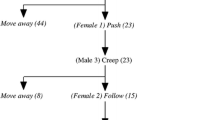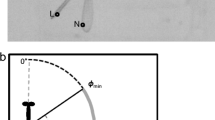Abstract
Male guppies Poecilia reticulata exhibit two types of mating behavior, i.e., courtship displays for cooperative copulation and sneaking attempts for forced copulation. The frequencies of the two male mating behaviors are influenced by tail length. Males possessing long tails exhibit courtship displays less frequently and sneaking attempts more frequently than those possessing short tails, even though they have similar total lengths. To examine whether these male behavioral tendencies depending on tail length are genetically controlled or are determined by tail length per se, tail length manipulation was conducted. The tail lengths of males that had previously possessed longer tails were surgically shortened to a greater degree than those of their counterparts that had previously possessed shorter tails. Although the frequencies of the mating behaviors exhibited by the latter males did not apparently change, the former males clearly increased the frequency of courtship displays and decreased that of sneaking attempts following tail shortening. These results indicate that males adjust the frequencies of the two mating behaviors according to their tail length. Since females avoid cooperative mating with males possessing long tails, the change in mating behavioral patterns by males depending on their tail length may increase their mating opportunities.


Similar content being viewed by others
References
Andersson M (1994) Sexual selection. Princeton University Press, Princeton, NJ
Basolo AL, Alcaraz G (2003) The turn of the sword: length increases male swimming costs in swordtails. Proc R Soc Lond B 270:1631–1636
Borg ÅA, Forsgren E, Magnhagen C (2002) Plastic sex-roles in the common goby—the effect of nest availability. Oikos 98:105–115
Brockmann HJ (2001) The evolution of alternative strategies and tactics. Adv Stud Behav 30:1–51
Brooks R, Endler JA (2001) Direct and indirect sexual selection and quantitative genetics of male traits in guppies (Poecilia reticulata). Evolution 55:1002–1015
Emlen DJ (1997) Alternative reproductive tactics and male-dimorphism in the horned beetle Onthophagus acuminatus (Coleoptera: Scarabaeidae). Behav Ecol Sociobiol 41:335–341
Evans JP, Kelley JL, Ramnarine IW, Pilastro A (2002) Female behaviour mediates male courtship under predation risk in the guppy (Poecilia reticulata). Behav Ecol Sociobiol 52:496–502
Figueira WF, Lyman SJ (2007) Context-dependent risk tolerance of the bicolour damselfish: courtship in the presence of fish and egg predators. Anim Behav 74:329–336
Garant D, Dodson JJ, Bernatchez L (2003) Differential reproductive success and heritability of alternative reproductive tactics in wild Atlantic salmon (Salmo salar L.). Evolution 57:1133–1141
Gross MR (1996) Alternative reproductive strategies and tactics: diversity within sexes. Trends Ecol Evol 11:92–98
Hailey A, Willemsen RE (2000) Population density and adult sex ratio of the tortoise Testudo hermanni in Greece: evidence for intrinsic population regulation. J Zool Lond 251:325–338
Höglund J, Alatalo RV, Lundberg A, Rätti O (1994) Context-dependent effects of tail-ornament damage on mating success in black grouse. Behav Ecol 5:182–187
Houde AE (1997) Sex, color and mate choice in guppies. Princeton University Press, Princeton, NJ
Howard RD (1984) Alternative mating behaviors of young male bullfrogs. Am Zool 24:397–406
Itzkowitz M, Iovine MK (2007) Single gene mutations causing exaggerated fins also cause non-genetic changes in the display behavior of male zebrafish. Behaviour 144:787–795
Karino K, Haijima Y (2001) Heritability of male secondary sexual traits in feral guppies in Japan. J Ethol 19:33–37
Karino K, Haijima Y (2004) Algal-diet enhances sexual ornament, growth and reproduction in the guppy. Behaviour 141:585–601
Karino K, Kobayashi M (2005) Male alternative mating behaviour depending on tail length of the guppy, Poecilia reticulata. Behaviour 142:191–202
Karino K, Matsunaga J (2002) Female mate preference is for male total length, not tail length in feral guppies. Behaviour 139:1491–1508
Karino K, Shinjo S (2004) Female mate preference based on male orange spot patterns in the feral guppy Poecilia reticulata in Japan. Ichthyol Res 51:316–320
Karino K, Kobayashi M, Orita K (2006a) Costs of mating with males possessing long tails in the female guppy. Behaviour 143:183–195
Karino K, Orita K, Sato A (2006b) Long tails affect swimming performance and habitat choice in the male guppy. Zool Sci 23:255–260
Liley NR (1966) Ethological isolating mechanisms in four sympatric species of poeciliid fishes. Behaviour 13:1–197
Luyten PH, Liley NR (1985) Geographic variation in the sexual behaviour of the guppy, Poecilia reticulata (Peters). Behaviour 95:164–179
Magellan K, Pettersson LB, Magurran AE (2005) Quantifying male attractiveness and mating behaviour through phenotypic size manipulation in the Trinidadian guppy, Poecilia reticulata. Behav Ecol Sociobiol 58:366–374
Magurran AE (2005) Evolutionary ecology: the Trinidadian guppy. Oxford University Press, Oxford, UK
Magurran AE, Nowak MA (1991) Another battle of the sexes: the consequences of sexual asymmetry in mating costs and predation risk in the guppy, Poecilia reticulata. Proc R Soc Lond B 246:31–38
Matthews IM, Evans JP, Magurran AE (1997) Male display rate reveals ejaculate characteristics in the Trinidadian guppy Poecilia reticulata. Proc R Soc Lond B 264:695–700
Mazzoldi C, Scaggiante M, Ambrosin E, Rasotto MB (2000) Mating system and alternative male mating tactics in the grass goby Zosterisessor ophiocephalus (Teleostei: Gobiidae). Mar Biol 137:1041–1048
Nicoletto PF, Kodric-Brown A (1999) The relationship among swimming performance, courtship behavior, and carotenoid pigmentation of guppies in four rivers of Trinidad. Env Biol Fish 55:227–235
Ojanguren AF, Magurran AE (2004) Uncoupling the links between male mating tactics and female attractiveness. Proc R Soc Lond B 271:S427–S429
Ortega J, Arita HT (2002) Subordinate males in harem groups of Jamaican fruit-eating bats (Artibeus jamaicensis): satellites or sneaks? Ethology 108:1077–1091
Pilastro A, Bisazza A (1999) Insemination efficiency of two alternative male mating tactics in the guppy (Poecilia reticulata). Proc R Soc Lond B 266:1887–1891
Pryke SR, Andersson S (2005) Experimental evidence for female choice and energetic costs of male tail elongation in red-collared widowbirds. Biol J Linn Soc 86:35–43
Reichard M, Smith C, Jordan WC (2004) Genetic evidence reveals density-dependent mediated success of alternative mating behaviours in the European bitterling (Rhodeus sericeus). Mol Ecol 13:1569–1578
Reynolds JD, Gross MR, Coombs MJ (1993) Environmental conditions and male morphology determine alternative mating behaviour in Trinidadian guppies. Anim Behav 45:145–152
Ryan MJ, Causey BA (1989) “Alternative” mating behavior in the swordtails Xiphophorus nigrensis and Xiphophorus pygmaeus (Pisces: Poeciliidae). Behav Ecol Sociobiol 24:341–348
Sato A, Karino K (2006) Use of digitally modified videos to examine female mate preference for orange spot coloration of males in the guppy, Poecilia reticulata. Ichthyol Res 53:398–405
Shuster SM, Wade MJ (1991) Equal mating success among male reproductive strategies in a marine isopod. Nature 350:608–610
Shuster SM, Wade MJ (2003) Mating systems and strategies. Princeton University Press, Princeton, NJ
Spence R, Smith C (2005) Male territoriality mediates density and sex ratio effects on oviposition in the zebrafish, Danio rerio. Anim Behav 69:1317–1323
Su KFY, Li D (2006) Female-biased predation risk and its differential effect on the male and female courtship behaviour of jumping spiders. Anim Behav 71:531–537
Zimmerer EJ, Kallman KD (1989) Genetic basis for alternative reproductive tactics in the pygmy swordtail, Xiphophorus nigrensis. Evolution 43:1298–1307
Acknowledgments
We are grateful to A. Sato for help with data collection and valuable discussion, and to anonymous reviewers for useful comments. This work was supported by Grant-in-Aids for Scientific Research (C) (#16570012 & #19570015) to K.K. from the Japan Society for the Promotion of Science. This study complies with the current laws of Japan as well as the guidelines of the Animal Care and Use Committee of Tokyo Gakugei University.
Author information
Authors and Affiliations
Corresponding author
About this article
Cite this article
Karino, K., Kamada, N. Plasticity in courtship and sneaking behaviors depending on tail length in the male guppy, Poecilia reticulata . Ichthyol Res 56, 253–259 (2009). https://doi.org/10.1007/s10228-008-0093-7
Received:
Revised:
Accepted:
Published:
Issue Date:
DOI: https://doi.org/10.1007/s10228-008-0093-7




